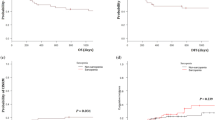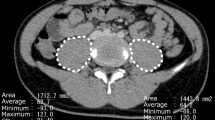Abstract
Muscle weakness is one of the most serious problems during chemotherapy for childhood hematological malignancies. It may be caused by long-term hospitalization, unfavorable physical conditions, and restricted activities. Although the concept of sarcopenia is becoming widely recognized, especially in geriatric medicine, there have been few reports about sarcopenia in pediatric patients with hematological malignancies. A total of 47 consecutive first-onset acute lymphoblastic leukemia (ALL) patients who underwent induction therapy between January 2011 and September 2016 were investigated. The cross-sectional psoas muscle area (PMA) was measured on computed tomography (CT) images. PMA changes were expressed as the Muscle Loss Index (MLI), which was calculated by dividing the post-treatment PMA by the pre-treatment PMA. In this study, patients with values less than the lowest quartile of MLI were classified into the sarcopenia group, and their basic and clinical factors were compared with those in the non-sarcopenia group. Muscle loss was observed in all patients after induction therapy, and severe adverse events during induction therapy were significantly more common in patients in the sarcopenia group. Furthermore, sarcopenia was found to be an independent prognostic factor for invasive fungal infection (IFI) that occurs after induction therapy. The evaluation of sarcopenia on CT images is easy and useful as a predictor of unfavorable events such as IFI in the treatment of childhood ALL.

Similar content being viewed by others
Abbreviations
- ALL:
-
Acute lymphoblastic leukemia
- PMA:
-
Psoas major muscle area
- CT:
-
Computed tomography
- MLI:
-
Muscle Loss Index
- IFI:
-
Invasive fungal infection
- NCI:
-
National cancer institute
- CTCAE:
-
Common terminology criteria for adverse events
References
Rosenberg I. Summary comments. Am J Clin Nutr. 1989;50:1231–3.
Hara N, Iwasa M, Sugimoto R, Mifuji-Morooka R, Yoshikawa K, Terasawa E, et al. Sarcopenia and sarcopenic obesity are prognostic factors for overall survival in patients with cirrhosis. Intern Med. 2016;55:863–70.
Begini P, Gigante E, Atonelli G, Carbonetti F, Iannicelli E, Anania G, et al. Sarcopenia predicts reduced survival in patients with hepatocellular carcinoma at first diagnosis. Ann Hepatol. 2017;16:107–14.
Rayar M, Webber CE, Nayiager T, Sala A, Barr RD. Sarcopenia in children with acute lymphoblastic leukemia. J Pediatr Hematol Oncol. 2013;35:98–102.
Kobayashi R, Kaneda M, Sato T, Ichikawa M, Suzuki D, Ariga T. The clinical feature of invasive fungal infection in pediatric patients with hematologic and malignant diseases: a 10-year analysis at a single institution at Japan. J Pediatr Hematol Oncol. 2008;30:886–90.
Takagi K, Yoshida R, Yagi T, Umeda Y, Nobuoka D, Kuise T, et al. Radiographic sarcopenia predicts postoperative infectious complications in patients undergoing pancreaticoduodenectomy. BMC Surg. 2017;17:64.
Cruz-Jentoft AJ, Baeyens JP, Bauer JM, Boirie Y, Cederholm T, Landi F, et al. Sarcopenia: European consensus on definition and diagnosis: report of the European Working Group on sarcopenia in older people. Age Ageing. 2010;39:412–23.
Fielding RA, Vellas B, Evans WJ, Bhasin S, Morley JE, Newman AB, et al. Sarcopenia: an undiagnosed condition in older adults. Current consensus definition: prevalence, etiology, and consequences. International Working Group on sarcopenia. J Am Med Dir Assoc. 2011;12:249–56.
Chen LK, Liu LK, Woo J, Assantachai P, Auyeung TW, Bahyah KS, et al. Sarcopenia in Asia: consensus report of the Asian Working Group for Sarcopenia. J Am Med Dir Assoc. 2014;15:95–101.
Hanaoka M, Yasuno M, Ishiguro M, Yamauchi S, Kikuchi A, Tokura M, et al. Morphologic change of the psoas muscle as a surrogate marker of sarcopenia and predictor of complications after colorectal cancer surgery. Int J Colorectal Dis. 2017;32:847–56.
Ikeno Y, Koide Y, Abe N, Matsueda T, Izawa N, Yamazato T, Matsumori M, Tanaka H, Ishihara S, Nakayama S, Sugimoto K, Okita Y, et al. Impact of sarcopenia on the outcomes of elective total arch replacement in the elderly. Eur J Cardiothorac Surg. 2017;51:1135–41.
Harada K, Suzuki S, Ishii H, Aoki T, Hirayama K, Shibata Y, et al. Impact of skeletal muscle mass on long-term adverse cardiovascular outcomes in patients with chronic kidney disease. Am J Cardiol. 2017;119:1275–80.
Author information
Authors and Affiliations
Corresponding author
Ethics declarations
Conflict of interest
The authors declare that they have no conflict of interest.
About this article
Cite this article
Suzuki, D., Kobayashi, R., Sano, H. et al. Sarcopenia after induction therapy in childhood acute lymphoblastic leukemia: its clinical significance. Int J Hematol 107, 486–489 (2018). https://doi.org/10.1007/s12185-017-2388-9
Received:
Revised:
Accepted:
Published:
Issue Date:
DOI: https://doi.org/10.1007/s12185-017-2388-9




